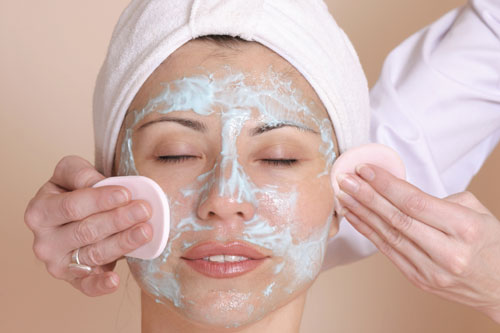 A chemical peel, also known as a chemexfoliation, is a cosmetic and medical procedure designed to improve the appearance of a patient’s skin (usually the face), as well as to treat certain dermatological disorders such as acne.
A chemical peel, also known as a chemexfoliation, is a cosmetic and medical procedure designed to improve the appearance of a patient’s skin (usually the face), as well as to treat certain dermatological disorders such as acne.
There are many different types of chemical peels, but each involve the application of an acidic solution which “burns” the upper layers of skin away, thereby allowing new, healthier looking skin to surface.
The process of removing old, desiccated skin is a natural occurrence; a chemical peel simply speeds this process up. Because the solution stings when applied, patients are advised to take an over-the-counter pain killer prior to the treatment.
Chemical Peel Solutions
Alpha-hydroxy Acid
One of the most popular solutions for a chemical peel is known as alpha-hydroxy acid (AHA), and is commonly sold in stores for home use; albeit, in concentrations of less than 10 percent, significantly lower than what a medical professional would use on a patient. One type of AHA is known as Glycolic Acid, a natural substance found in sugarcane and many types of fruit.
It’s typically used in concentrations of 20 to 80 percent; the stronger concentration offering the most benefits. Alpha-hydroxy acid peels are best as an acne treatment, but are somewhat beneficial as a treatment for fine lines, uneven pigmentation, and deep wrinkles.
The risks are generally low, and the recovery time is short. Immediately following the chemical peel, patients can expect peeling and redness which can last between one and three weeks.
The effects of the treatment generally last between one and three months, with another treatment being necessary to maintain skin appearance. The average cost for an alpha-hydroxy peel is $188 per treatment.
Trichloroacetic Acid
The most common solution for a chemical peel is known as trichloroacetic acid (TCA). It works by burning away surface skin, thereby allowing newer skin to take its place. In higher concentrations, it proves to be more beneficial than AHA as a treatment for uneven pigmentation, acne, acne scars, and deep wrinkles.
The effects of a TCA peel last much longer than an AHA peel, typically a year or more. However, the risk of complication from a TCA peel is much higher, and the recovery time is much longer. Trichloroacetic acid will increase a patient’s sensitivity to ultraviolet light, which can cause a plethora of problems, including severe burn and infection.
There is also the risk of pigmentation problems, both hypo and hyper pigmentation (the lightening and darkening of skin). The average cost of a TCA chemical peel is $378 per treatment.
Phenol Peel
The strongest peel offered, a phenol peel, is the most effective treatment for all skin conditions previously mentioned, and it’s benefits can last up to 20 years. But it’s also the one which carries the longest recovery time and the most risks, including but not limited to cardiac problems.
In treating severe skin conditions, many physicians will opt for laser treatments as a result of the risks associated with phenol peels. Its aggressiveness oftentimes prevents a patient’s skin from producing pigment, thus resulting in pigmentation problems. It is because of this phenol peels are best for those with fairer skin.
When absorbed through the skin, phenol has been shown to cause dysrhythmia (abnormal heart rhythms), which can be fatal for those with a pre-existing heart condition. It is because of this, doctors closely monitor patients’ heartbeats during this type of chemical peel. The average cost for a phenol peel is $1100 per treatment.
Am I A Good Candidate For A Chemical Peel?
If you suffer from acne, acne scars, uneven pigmentation, and wrinkles, a chemical peel may be an appropriate treatment option. Generally those with fairer skin have the best results, but darker skinned people may also have good results. Tell your plastic surgeon or dermatologist if you’re on certain medications such as Retinoid-A, as it can intensify the effects of certain peel types.
Recovery & Side Effects
How long your recovery will last, as well as what side effects you may experience, depend heavily on the type of chemical peel you have done. But all chemical peels will cause redness, peeling, and general skin irritation for a week or more following the procedure. To lessen this, patients are advised to stay out of the sun, or at the very least wear sunscreen when going out is unavoidable.
Pigmentation problems and scarring are the biggest risks associated with a chemical peel. If scarring occurs, skin treatment is available which generally produces good results. The risk of pigmentation problems is increased when the patient is taking birth control, so always tell your doctor what medications you are taking before the chemical peel.
